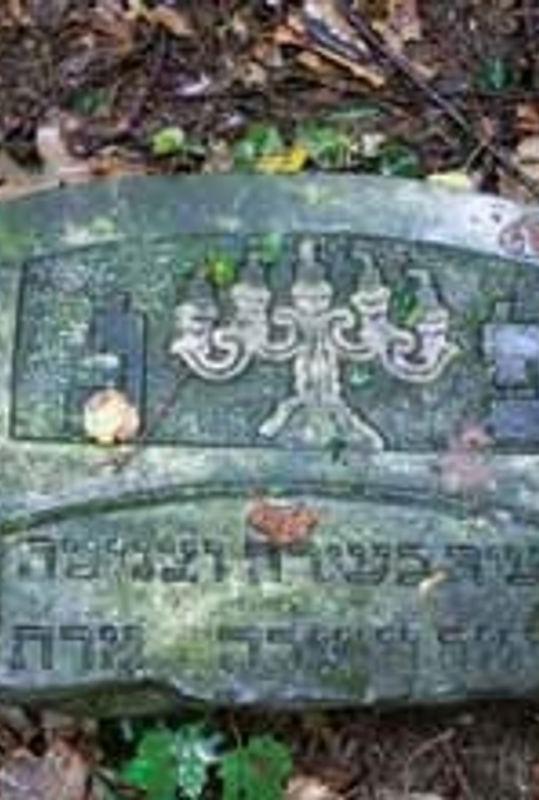New cemetery (Mickiewicza Street)- In the late 19th century. At the then-new St. A new cemetery has been established in the area known as Borek. It was in active use until 1943. June 22, 1942. At the cemetery, the Nazis executed more than 1,000 Jews from the Sandia ghetto, including Jews from Germany, the Czech Republic and other countries. After the war, thanks to the efforts of a local school teacher, the necropolis area was wooded, so it was not turned into a farm field. The cemetery contains more than a dozen sandstone tombstones, including one standing and several overturned, with visible decorations and inscriptions in Hebrew. The oldest of these dates to 1906. In the 1990s. On the initiative of Jewish organizations in Augsburg, a stone was placed in the cemetery to commemorate the annihilation of the Jews of Germany and the Jewish citizens of Sands, murdered during the Nazi occupation. The monument was soon vandalized - a plaque was stolen, and another, with the inscription: "To the murdered Jewish victims in memory, to future generations as a warning," appeared in 2006. Inventory and cleanup work has taken place at the cemetery several times.Holocaust - Just before the German army occupied Piaski with the Red Army, a large group of local Jews fled eastward. Probably after the Red Army withdrew from the city, and before the Germans entered, there was a pogrom - in retaliation for allegedly favoring the Bolsheviks.Several Jews were killed then. Soon after, refugees from other localities began arriving in the city, including more than 565 Jews from Szczecin (February 1940), a small group of Jews from Krakow (December 1940) and several hundred displaced persons from Lublin (March 1941). In the spring of 1940, the Germans established a twelve-member Judenrat in Piaski, with merchant Mendel Polisecki as its chairman.Under the auspices of the Judenrat, a kitchen for the poorest functioned. In December 1940. In Piaski, the Germans established an open ghetto - one of the first in the Lublin region. It was located in the eastern part of the city, within Gardzienicka, Bednarska, Szewska, Księża, Rybna, Kozia, Pocztowa, Furmańska, Krótka and Kościelna Streets.The ghetto was divided by Gardzienicka Street. Lublin. The larger ghetto was located on the site of the current PKS station and part of the residential area (up to the fire station), while the smaller ghetto was located on the other side of the street. Lublin. In the spring of 1941. Both parts of the ghetto were fenced with a wooden fence topped with barbed wire, and in September 1941. The ghetto was finally closed.In the early spring of 1942. The Germans carried out two deportation operations, as a result of which a total of about 4,000 people were sent from the Sandomierz ghetto to the Belzec death camp (March 23 - approx. 2,000 people from Piaski in a mass transport from the station in Trawniki of about 3,300 Jews, and on April 10 - about 2,000 people). From February 1942. The ghetto in Piaski began to function as a so-called "ghetto. transit ghetto.Transports of Jews were brought to it, among others. from Western Europe.At the end of February 1942. brought to Sands ca. 1,200 people from Munich, on March 23 - 986 Jews from various locations in Germany, on March 28 - 972 Jews from Berlin, on April 1 - several hundred Jews from the Terezin ghetto (some of the transport of 1,000 were incarcerated at Majdanek), on April 14 - several hundred Jews from Berlin and on April 23 - 460 Jews from Terezin. In the fall of 1942. An unspecified number of Jews from the residual ghetto in Majdan Tatarski in Lublin were transported to the Piaski ghetto, while on October 28 some Jews from the Lublin district (including those from Mętow, Glusk, Puchaczow and Mełgwia) were resettled here. It is likely that several deportation actions from Piaski to the Sobibor death camp took place in the summer and fall.The liquidation of the ghetto began in the fall of 1942. In late October and early November 1942. A secondary ghetto was established in Piaski, serving as a concentration point for several hundred Jews.On November 8, at the new Jewish cemetery, the Germans shot about 2,000 people from the ghetto. The liquidation of the secondary ghetto took place in February or March 1943.About 300 people in the ghetto were taken to the labor camp in Trawniki. Of all the Jews housed in the Piaski ghetto, some survived the war. 35 people, mostly young men, who escaped from the ghetto even before the deportations and joined partisan units operating in the surrounding forests. A dozen Jews survived by taking refuge in the homes of Poles in neighboring towns.
6. Piaski - Nowy cmentarz żydowski (ul. Mickiewicza)
Stories
Piaski - New Jewish cemetery (Mickiewicza Street).
Jewish History Tours

Powered by Clio Muse Tours
Powered by Clio Muse Tours
